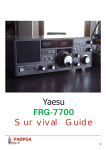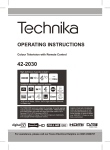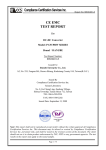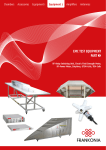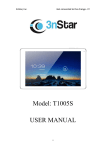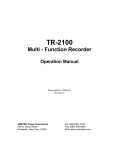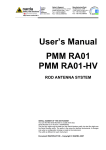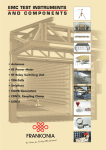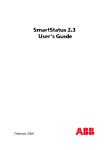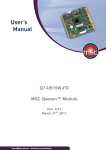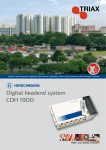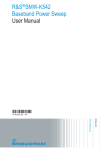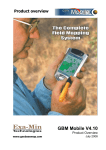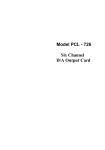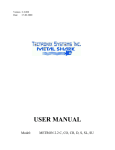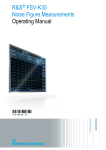Download USER MANUAL - R. A. Mayes Company
Transcript
USER MANUAL CIT-10 CIT-10/75 RF - GENERATOR / AMPLIFIER HF-VOLTMETER Available from Credence Technologies, Inc. Tel 831.459.7488, Fax 831.427.3513,http://www.credencetech.com Software-Version 1.13 13.10.2000 Contents 1.0 Introduction................................................................................................................................3 Safety Summary................................................................................................................................3 Accessories supplied with CIT-10:....................................................................................................3 Introduction......................................................................................................................................4 2.0 Installation and Configuration.....................................................................................................5 Hardware- and Software Requirements and Installation....................................................................5 Installation of NI-DAQ driver software and DAQ hardware..............................................................5 Installation of CIT-10 application software.......................................................................................5 Front Panel Features.........................................................................................................................6 Rear Panel Features..........................................................................................................................7 Installation of CIT-10.......................................................................................................................8 Operation..........................................................................................................................................8 3.0 Making Tests..............................................................................................................................9 3.1 Test procedure with coupling/decoupling networks.....................................................................9 Complete Test................................................................................................................................11 Selective Test.................................................................................................................................13 3.2 Test procedure with direct injection..........................................................................................14 3.3 Test procedure with EM-clamp.................................................................................................15 4.0 Calibration of Coupling Devices................................................................................................16 5.0 Miscellaneous...........................................................................................................................18 5.1 Generator..................................................................................................................................18 5.2 Voltmeter..................................................................................................................................18 5.3 Calibration of the CIT-10..........................................................................................................19 5.4 Accessory.................................................................................................................................20 5.5 Specifications............................................................................................................................21 5.6 Factory Calibration of the CIT-10.............................................................................................22 CIT-10 page 2 of 22 1.0 Introduction Safety Summary The following general safety precautions must be observed during all phases of operation, service, and repair of this instrument. Failure to comply with these precautions or with specific warnings elsewhere in this manual violates safety standards of design, manufacture, and intended use of this instrument. We assume no liability for the customer´s failure to comply with these requirements. Before applying power: Verify that the product is set to match the available line voltage and that the correct fuse is installed. Ground the instrument: This product is a Safety Class 1 Product (provided with a protective earthing ground incorporated in the power cord). The mains plug shall only be inserted in a socket outlet provided with a protective earth contact. Any interruption of the protective conductor inside or outside of the product is likely to make the product dangerous. Intentional interruption is prohibited. Do not remove instrument covers: Operating personnel must not remove instrument covers. There are no user serviceable parts inside. Refer servicing to qualified personnel. The CIT-10 shall only be operated by qualified personnel. Extensive knowledge of the Basic Standard is mandatory. The CIT-10 generates electromagnetic disturbances if operated as intended. In case of doubt the test setup shall be in a shielded room. Accessories supplied with CIT-10: PCI-6503, I/O-Card (ISA-Card on request) Power cord BNC cable, 1,5m Earth cable, 0,75m Attennuator Control cable, 3m; with PC-Interface Software WIN95/98, WIN NT, WIN 2000 CIT-10 page 3 of 22 Introduction Your CIT-10 is a fully automated system to perform immunity tests to conducted disturbances induced by radio frequency fields according to EN 61000-4-6/IEC 1000-4-6. The integrated broadband power amplifier (Class A) is capable of driving coupling/decoupling networks (CDN) as well as the EM-Clamp up to the highest test levels (U0=10V, Level 3) with exellent signal quality. Network Network Internet Intranet Equipment under Test PC-based CIT-10 Data Akquisition Card Fig.1: Principle of computer-based instrument Your CIT-10 is a computer-based instrument. A computer-based system can perform the same tasks as traditionel instruments with the added benefits of flexibility and efficiency. Once the driver and application software are installed you immediately start testing. The results are printed, saved or distributed over your companies intranet or the world wide web. The calibration for all coupling/decoupling devices is performed automatically, with the software creating a specific calibration file for any individual CDN or EM-clamp. No calibration at all is needed for our CDNs or EM-clamp - they are delivered factory calibrated with a calibration file. Our software is programmed in LabVIEW, the industry´s most popular instrumentation software. This makes it easy to integrate our application software into measurement and automation systems. Every analog or digital signal of the EUT may be monitored with a separate DAQ-card or with ANA_1020, signal acquisition module (only analog signals). So it´s easy to display the EUT´s output signal as a function of the disturbing frequency. The CIT-10 is composed by three function blocks, which can all be driven separately: RF-generator, broad band power amplifier and RF-voltmeter. CIT-10 page 4 of 22 2.0 Installation and Configuration Hardware- and Software Requirements and Installation You should have the following hardware and software to work with your CIT-10: PC with Windows 95/98 or Windows NT operating system, compatible mouse and VGA graphics (min. 800 x 600 pts.). Follow the next four steps: Step 1 : Install your NI-DAQ driver software Step 2 : Install your DAQ hardware device Step 3 : Install your CIT-10 application software Step 4 : Connect your CIT-10 and start operation Installation of NI-DAQ driver software and DAQ hardware All running applications on your PC must be closed. Insert your NI-DAQ driver CD and click on setup.exe. Follow the installation wizard and choose the default values at „Select components“. After installing your driver software, you are ready to install the DAQ board into your computer. In all cases, install your NI-DAQ software prior to installing your DAQ hardware! Reboot your computer. Configure your device using the NI-DAQ Configuration Utility. Enter „device number“ 2. Installation of CIT-10 application software Insert the application software CD and click on setup.exe Follow the instructions on your screen. The installer creates a directory named „CDG_E“, where you can doubleclick on „61000-4-6.exe“ to start the application. Copy the calibration files of your coupling/decoupling devices into the directory CDG_E/Data. CIT-10 page 5 of 22 Front Panel Features 3 2 1 4 5 [1]: Earth Terminal For connection of the supplied earth cable to the ground reference plane. [2]: HF in Input of the RF-Voltmeter [3]: Thermal Protection Indicates thermal overload of the power amplifier. Cooling down resets the amplifier automatically. [4]: HF out Output of the broadband power amplifier [5]: Power Line switch turns the CIT-10 on and off CIT-10 page 6 of 22 Rear Panel Features 14 Amplifier in Generator out 6 7 8 Centronics-Buchse EUT fail 9 AM extern 12 10 13 11 Artificial Hand [6]: Centronics-Connector, 36-pol Connect to Centronics cable. Connect the PC-Interface between Centronics cable and your computer´s DAQ card. [7]: EUT fail TTL/CMOS compatible input. Stops running application or sets a frequency mark. [8]: Generator out Drives the built in broadband power amplifier. Connected to [10] (default). May be split up for use with external power amplifiers. [9]: AM extern Input for external modulation signal, for generation of non-standard amplitude modulated test signals. [10]: Amplifier in Input of broadband power amplifier. Connected to [8] (default). [11]: Artificial Hand Input for artificial hand in accordance with IEC CISPR 16-1 (200pF and 500 series to ground). connected in [12]: Power input Input for the line power source. Line Fuse: Replace only with a fuse of the same rating. See the label on the rear panel. [13]: Earth Terminal Same as [1] on front panel. [14]: Voltage selector - verify that the product is set to match the available line voltage CIT-10 page 7 of 22 Installation of CIT-10 Connect the supplied power cable to terminal [12] on the back panel. Connect the PC-Interface to the DAQ card in your computer. Connect the Centronics cable between PC-Interface and your CIT-10. The test set up for table-top and floor-standing equipment is according to chapter 7 of EN 61000-4-6. CIT-10: Connect the supplied BNC cable between amplifier out [4] and the supplied 6 dBattenuator. The 6 dB-attenuator should be placed to the coupling device as near as possible. Operation After installing the CIT-10 and arranging the test set up, you are ready to Double-click on „61000-4-6.exe“ (Directory „CDG_E/61000-4-6.exe“). The following window is displayed. Press the „Generator“ button to operate the RF-Generator as a „stand alone“-device. For more information see chapter 5.1. Press the „RF-Voltmeter“ button to operate the RF-Voltmeter as a „stand alone“-device. For more information see chapter 5.2. Press the „Test“ button to perform immunity tests according to EN 61000-4-6. For more information see chapter 3. Press the „CDN-Calibration“ button to comfortably calibrate any coupling/decoupling device. A calibration file is generated automatically. For more information see chapter 4. Press the „Self-Calibration“ button, to generate a new CIT-10 calibration file. For more information see chapter 5.3. CIT-10 page 8 of 22 3.0 Making Tests Tests with different injection methods are described in the following pages. If suitable CDNs are available they shall be used. For coupling of supply lines CDNs are mandatory! For screened cables direct injection shall be used. For multi-conductor cables and bundles of cables the EM-clamp shall be selected. 3.1 Test procedure with coupling/decoupling networks The test set up for a single safety class 2 product is shown in Fig.2. 50 CDN-T2 0,5 m To AE or telecomm. lines Balanced pair 50 Mains CDN-M2 Mains EUT Unscreened unbalanced two-wire CDN-AF2 Insulating support h = 0,1 m AE 6 dB Attenuator Reference ground plane Conducted Disturbances Test generator Fig.2: Test setup for a single safety class 2 product All instructions of the basic standard should be noticed. The EUT shall be placed on an insulating support, 0,1 metre above the ground reference plane. For table-top equipment, the ground reference plane may be placed on a table. On all cables to be tested, coupling and decoupling devices shall be inserted. The coupling and decoupling devices shall be placed on the ground reference plane, making direct contact with it at about 0,1 - 0,3 metre from the EUT. CIT-10 page 9 of 22 The cables between the coupling and decoupling devices and the EUT shall be as short as possible and shall never be bundled or wrapped. Their height above the ground reference plane shall be between 30 and 50 mm (where possible). CIT-10: The 6 dB attenuator shall be placed to the coupling and decoupling device as near as possible. Warning! Capacitors bridge to live parts in the mains coupling and decoupling networks. Due to the high leakage currents, mains CDNs shall have a earth terminal which shall remain connected to the protective earth (PE) under all test conditions. Click on the „Test“ button or use function key F1 on your keyboard. The following window is displayed: Choose your coupling/decoupling device from the selector box „Coupling device“. Each coupling/decoupling device whose calibration files are copied into the directory CIT10\Data is displayed in this box. Choose calibration level and test level identical to achieve maximum accuracy! „Standard test“ gives you the choice of three different settings: - „Calibration fixed“ means that test level and calibration level are identical. Only start and stop frequency may be varied. - „Calibration free“ allows you to vary start and stop frequency, dwell time and modulation. - „Extrapolation“ means that each parameter may be varied. Even the test level may be different from the calibration level. CIT-10 CIT-10: Enter your test level into the box with the same name. This setting depends on the box „Standard test“: - the test level is identical to the calibration level of the coupling/decoupling device if page 10 of 22 FRANKONIA EMV-Mess-Systeme GmbH „Calibration fixed“ or „Calibration free“ is displayed in the box „Standard test“ - enter values between 1 V and 10 V if „Extrapolation“ is displayed. Enter values between 10 V and 15 V if the coupling/decoupling device was calibrated without the 6dB attenuator (Precompliance) CIT-10/75: Enter your test level into the box with the same name. This setting depends on the box „Standard test“: - the test level is identical to the calibration level of the coupling/decoupling device if „Calibration fixed“ or „Calibration free“ is displayed in the box „Standard test“ - enter values between 1 V and 25 V if „Extrapolation“ is displayed. Minimum value of start frequency is 0,15 MHz Maximum value of stop frequency is 230 MHz Frequency steps may vary between 0,1% and 100% (except standard levels) Dwell time may vary between 0,2 s and 100 s (except standard levels) The box „Modulation“ may be switched between internal and external modulation. If you need non-standard test signals choose „external“. The external modulation signal shall be connected to terminal [9] on the instruments back panel. „EUT fail signal“ indicates how the programm shall react if a high level is connected to terminal [7] on the instruments back panel. „Test Stop“ means, the programm stops if a high-level is recognized „No Test Stop“ sets a frequency mark which may be edited after test stop The directory for the calibration files is displayed at the bottom of the window. It may be altered on request. Each coupling/decoupling device whose calibration file is copied into this directory is displayed in the box „Coupling device“. Now you have to choose wether a complete test (sweep from start frequency to stop frequency) or a selective test (choose a single frequency) is performed. Complete Test Click on „Complete Test“ or press function key F1.The following window is displayed: Frequency and generator level are displayed while the test is running. If the EUT shows any reaction to the injected disturbing frequencies, you may set a frequency mark by pressing function key F10. After test stop you may edit this list of frequency marks, add comments, save or CIT-10 page 11 of 22 print the list. Click the „Test Stop“ button or press „esc“ to interrupt the test. The following window is displayed: Click on „Step up“ or „Step down“ to examin nearby frequencies or press function keys (Page up) or (Page down). Test level (F1) and amplitude modulation (F2) may be switched on or off. Even during the interruption you may add additional frequency marks (F10). There is a possibility to add comments to each frequency mark too. After the examination you may go on with the test (Return) or stop it (esc). After the test has finally finished the „Test“-window is displayed again. Click „Protocol“ (F3) to edit the list of frequencies (F4). You may add (F1) or delete (F2) frequencies and add corresponding remarks. Click on „OK“ (esc) to close the window. Finally you may save (F2) or print (F3) the protocol. You may also load (F1) protocols of previous test and edit them in the same way. CIT-10 page 12 of 22 Selective Test Click on „Selective test“ (F2) while the „Test“-window is displayed to show the next window: Enter frequency and test level into the appropriate boxes. Amplitude modulation (F2) and test level (F1) may be switched on or off. Stop the test (esc) by clicking the button with the same name. After clicking on „Ramp function“ the following window is displayed: Now you can sweep from a startlevel to a stoplevel at fixed frequency. To start the programmed ramp function click on the button with the same name. After reaching the stoplevel the disturbing signal is stopped automatically. Even with the ramp function the amplitude modulation may be switched on or off. CIT-10 page 13 of 22 3.2 Test procedure with direct injection The disturbing signal, coming from the test generator is galvanically injected to screened and coaxial cables via a 100 resistor. In between the auxiliary equipment and the injection point a decoupling network shall be inserted as close as possible to the injection point, Fig.3. 0,1 m < L < 0,3 m W all of shielded room EUT *) Auxiliary equipm ent (AE) Ferrite ring cores 50 CDN-M3 30m m 100 Short earth cable 0,1 m Ground reference plane 6dB Attenuator *) Close to injection point 50 Test generator Fig.3: Principle of direct coupling to screened cables. For certain simple screened cable configurations, the decoupling circuit together with the 100 can be combined into one box. resistor The coupling/decoupling networks CDN 801-S1, CDN 801-S2, CDN 801-S9 and CDN 801-S25 are examples of this configuration. Main advantage of these CDN´s is a simpler operation. Otherwise the test pocedure with direct coupling is identical to the test procedure with CDN´s as described above. At the main menu choose „Test“ or use function key F1 on your keyboard. CIT-10 Follow chapter 3.1 to go on. page 14 of 22 3.3 Test procedure with EM-clamp With clamp injection devices, the coupling and decoupling functions are separated. Coupling is provided by the clamp-on device while the common-mode impedance and the decoupling functions are established at the auxiliary equipment, Fig.4. The electromagnetic clamp combines capacitive and inductive coupling to the cables. L < 0,3 m where possible 0,1 m < L < 0,3 m Ferrite Auxiliary equipm ent (AE) 50 EUT Clam p injection device 50 Z ce CDN-M 3 CDN-M 3 30m m Short connection to earth 50 6dB Attenuator 0,1 m Ground reference plane Test generator Fig.4: Principle of coupling and decoupling according to the clamp injection method When using clamp injection, the Auxiliary Equipment (AE) setup shall embody the common-mode impedance as required as close as possible. Each AE used with clamp injection shall represent the functional conditions as close as possible. To approximate the required common-mode impedance the following measures need to be taken: Each AE, being subject for use with clamp injection, must be placed on an insulating support 0,1 metre above the ground plane. All cables connected to each AE, other than those being connected to the EUT, shall be provided with decoupling networks. These decoupling networks (measures) shall be applied no further than 0,3 metre from the AE. The cable(s) in between the AE and the decoupling network(s) or in between the AE and the injection clamp shall never be bundled nor wrapped and kept between 30 and 50 mm above the ground reference plane where possible. The cable length in between the AE and the EM clamp shall be as short as possible (≤ 0,3m), to improve reproducibility at higher frequencies (> 30 MHz). The decoupling network installed on the cable, electrically closest to the one(s) being tested shall be replaced by a CDN which is terminated at its input port with 50Ω and as such represents the 150Ω loading of the AE to the ground reference plane. At the main menu choose „Test“ or use function key F1 on your keyboard. CIT-10 Follow chapter 3.1 to go on. page 15 of 22 4.0 Calibration of Coupling Devices Coupling devices shall be calibrated before first use (except CDN´s from our company because these are supplied with corresponding calibration files). (Re-) calibration is recommended if the test setup is different from the calibration setup (e.g. different cables, different cable lengths etc.). 6 dB Attenuator 30mm 150 Test generator IN *) 150 50 AE EUT to 50 adaptor 100 HF-Voltmeter Coupling/decoupling device Ground reference plane Common-mode points *) The 150 loading (e.g. a 150 to 50 adaptor terminated with a 50 load) at the AE-port shall only be applied to unscreened cables (screened cables will have their screen connected to the ground reference plane at the AE-side). Fig.5: Setup for level setting at the EUT-port of coupling and decoupling devices The setup for level setting is given in Fig.5 for all coupling and decoupling devices. CIT-10: The test generator (HF-out) shall be connected to the RF-input port of the coupling device via the 6dB-attenuator. The EUT port of the coupling device shall be connected in common-mode through the 150 to 50 adaptor to the HF-Voltmeters (Calibration). The AE-port shall be loaded in common-mode with a 150 50 to 50 adaptor, terminated with Suitable calibration adaptors are available from our company for all coupling and decoupling devices. CIT-10 Choose the „CDN-Calibration“ button or press function key F2 on your keyboard. The following window is displayed: page 16 of 22 Click on „Calibration Start“ Button (F1) to start the calibration. You can choose the frequency range of calibration between 0.15 MHz to 80 MHz or 0.15 MHz to 230 MHz. CIT-10: Enter test levels (calibration level) between 1V and 15V. Maximum accuracy is achieved if test level and calibration level are identical. CIT-10: For precompliance tests levels between 10V and 15V may be generated. Remove the 6dB attenuator at calibration levels above 10V. CIT-10/75: Enter test levels (calibration level) between 1V and 25V. Maximum accuracy is achieved if test level and calibration level are identical. CIT-10/75: Connect attenuator (20 dB / 0,5 W) in between „Generator out“ [8] and „ Amplifier in“ [10] on the back panel for small calibration levels (approx. < 2V). Attention: Test setup and calibration setup must be identical – don´t forget the attenuator! Frequency steps may vary between 0,1% and 100%. Return to the main menue by clicking the button of the same name (esc). CIT-10 page 17 of 22 5.0 Miscellaneous 5.1 Generator The output signal of the RF generator is provided at terminal [8] on the rear panel of your CIT-10. While the main menue is displayed choose the „Generator“ button or press function key F4 on your keyboard. The following window is displayed: Type frequency and level in to the corresponding boxes. Displayed is always the nonmodulated signal level. Choose level units dBm, dB V or dBmV. The signal level may be switched off or on. The amplitude modulation (AM) may be switched off or on. The amplitude modulation may be switched from internal to external. The input for the external modulation signal is terminal [9] on the rear panel of your CIT-10. Return to the main menue by clicking the button of the same name (esc). 5.2 Voltmeter The signal input for the RF voltmeter is provided at terminal [2] (Calibration) on the front panel of your CIT-10. While the main menue is displayed choose the „Voltmeter“ button or press function key F5 on your keyboard. The following window is displayed. The value is displayed in dBm, dB V or dBmV. Refresh time is 0.5 sec. Return to the main menue by clicking the button of the same name (esc). CIT-10 page 18 of 22 5.3 Calibration of the CIT-10 Your CIT-10 is delivered factory calibrated. Recalibration is usually not necessary. It may be useful to recalibrate the device prior to CDN calibration or after big variations of temperature. The CIT-10 shall warm up approx. 30 min. The supplied BNC cable is in between terminal [4] (HF out) and terminal [2] (Calibration). While the main menue is displayed choose the „Self-Calibration“ button or press function key F3 on your keyboard. While the calibration is running the following window is displayed. The calibration file „Amplifier.CDG“ is overwritten with the new calibration data. CIT-10 page 19 of 22 5.4 Accessory The accessory listed below may be ordered by our company either with the CIT-10 or separately. Coupling/decoupling networks Typ Application AEConnector EUTConnector CDN 801-M1 unscreened supply (mains) lines 4mm MC-Sockets 4mm MC-Sockets CDN 801-M2 unscreened supply (mains) lines 4mm MC-Sockets 4mm MC-Sockets CDN 801-M3 unscreened supply (mains) lines 4mm MC-Sockets 4mm MC-Sockets CDN 801-M5 unscreened supply (mains) lines 4mm MC-Sockets 4mm MC-Sockets CDN 801-M2+M3 unscreened supply (mains) lines 4mm MC-Sockets 4mm MC-Sockets CDN 801-S1 screened cables BNC BNC CDN 801-S2 screened cables XLR/Female XLR/Male CDN 801-S9 screened cables SubD 9pin female SubD 9pin male CDN 801-S25 screened cables SubD 25pin female SubD 25pin male CDN 801-AF2 unscreened nonbalanced lines Terminal block Terminal block CDN 801-AF4 unscreened nonbalanced lines Terminal block Terminal block CDN 801-AF6 unscreened nonbalanced lines Terminal block Terminal block CDN 801-AF8 unscreened nonbalanced lines Terminal block Terminal block CDN 801-T2 unscreened balanced pairs Terminal block Terminal block CDN 801-T4 unscreened balanced pairs Terminal block Terminal block CDN 801-T8 unscreened balanced pairs Terminal block Terminal block CDN 801-RJ11 unscreened data lines RJ11 Socket RJ11 Socket CDN 801-RJ45 screened data lines RJ45 Socket RJ45 Socket CDN 801-USB-C USB devices USB-A USB-B CDN 801-USB-P USB devices USB-B USB-A Calibration adaptors for all coupling devices ANA_1020, signal acquisition module for analog signals EMC-testtable with ground plane (stainless steel); metalfree construction Other accessories are available on request. CIT-10 page 20 of 22 5.5 Specifications RF Voltmeter Frequency range 100 kHz to 266 MHz Measuring range +37 dBm to – 40 dBm Accuracy 0,5 dB (+30 dBm to – 30 dBm) 1,0 dB (+37 dBm to – 40 dBm) Resolution 0,1 dB VSWR < 1,1 : 1 Generator Frequency range 100 kHz to 266 MHz Resolution 1 Hz Accuracy (frequency) 10 ppm 20 ppm 35 ppm 55 ppm < 40 MHz < 80 MHz < 160 MHz > 160 MHz Output level -40 dBm to 0 dBm Resolution 0,1 dB Linearity 0,5 dB ( 1 dB max) Distortions Harmonics < 30 dBc Non-harmonics < 35 dBc Amplitude modulation 1 kHz 3%, 80% 5% (internal) 10 Hz to 100 kHz, 0 to 90% (external) Input impedance > 100 k VSWR < 1,3 : 1 Power amplifier CIT-10 CIT-10/75 Frequency range 100 kHz to 266 MHz 100 kHz to 230 MHz Gain 41 dBm 51 dBm Output power > 13 W 75 W Distortion < 20 dBc at nominal power < 25 dBc at 40 W < 2,0 : 1 < 1,2 : 1 (with 6 dB-attenuator) < 1,5 : 1 VSWR EUT-fail input Input Output 1,5 dB 1,0 dB TTL/CMOS compatible General data Temperature range 0 to 40 ° C Warm-up time 15 min Housing 19“ Subrack or desktop case Width / height / depth 84 TE / 3 HE / 365mm Volume of delivery CIT-10 (basic equipment), PCI digital I/O-Card, cabling, attenuator, system software CIT-10 page 21 of 22 5.6 Factory Calibration of the CIT-10 To ensure accuracy the CIT-10 shall be factory calibrated every year. Available from Credence Technologies, Inc. Tel 831.459.7488, Fax 831.427.3513,http://www.credencetech.com CIT-10 page 22 of 22






















